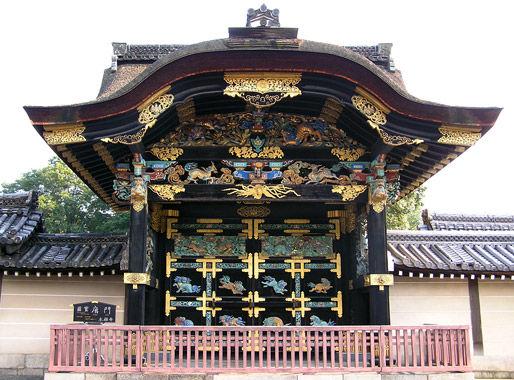|
||
 |
||

Honganji Karamon 本願寺唐門 (Kyoto)
(C)2001 Japanese Architecture and Art Net Users System. No reproduction or republication without written permission.
掲載のテキスト・写真・イラストなど、全てのコンテンツの無断複製・転載を禁じます。
|
||||||
| mukaikaramon 向唐門 | ||||||
| KEY WORD : architecture / gates | ||||||
| Also often read mukoukaramon . A four-legged gate *shikyakumon 四脚門, with undulating gables *karahafu 唐破風, over the front and back entrances. When an undulating bargeboard is attached to the eave ends it is called nokikarahafu 軒唐破風. Alternatively the entire gable may be one undulating piece that includes the undulating bargeboard. All such gates comsist of only one bay, including the entrance. The roof may also undulate following the curves of the gable. If the bargeboard is cusped, the rafters follow the same curve and are then called ibaradaruki 茨垂木, or cusped rafters. They were very popular during *Momoyana jidai 桃山時代. One example is the Honganji Mukaikaramon 本願寺向唐門 which was moved to Honganji in Kyoto in 1619. It has a hip-and-gable roof *irimoya yane 入母屋根, covered with cypress bark shingles *hiwadabuki 桧皮葺. Another example is the Daitokuji Mukaikaramon 大徳寺向唐門 (Momoyama period) in Kyoto. It has a gable roof *kirizuma yane 切妻屋根. | ||||||
 Honganji Karamon 本願寺唐門 (Kyoto)
|
||||||
| REFERENCES: | ||||||
| *hirakaramon 平唐門, *karamon 唐門 | ||||||
| EXTERNAL LINKS: | ||||||
| NOTES: | ||||||
| Honganji = Nishihonganji 西本願寺 | ||||||
(C)2001 Japanese Architecture and Art Net Users System. No reproduction or republication without written permission. 掲載のテキスト・写真・イラストなど、全てのコンテンツの無断複製・転載を禁じます。 |
||||||